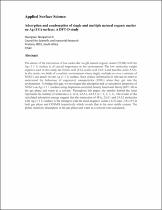 ResearchSpace
ResearchSpace
Adsorption and coadsorption of single and multiple natural organic matter on Ag (111) surface: A DFT-D study
JavaScript is disabled for your browser. Some features of this site may not work without it.
- ResearchSpace
- →
- Research Publications/Outputs
- →
- Journal Articles
- →
- View Item
| dc.contributor.author |
Nyangiwe, Nangamso N

|
|
| dc.contributor.author |
Ouma, Cecil NM

|
|
| dc.date.accessioned | 2020-10-05T09:14:04Z | |
| dc.date.available | 2020-10-05T09:14:04Z | |
| dc.date.issued | 2020-03 | |
| dc.identifier.citation | Nyangiwe, N.N. & Ouma, C.N.M. 2020. Adsorption and coadsorption of single and multiple natural organic matter on Ag (111) surface: A DFT-D study. Applied Surface Science, vol. 505, pp9 | en_US |
| dc.identifier.issn | 0169-4332 | |
| dc.identifier.issn | 1873-5584 | |
| dc.identifier.uri | https://www.sciencedirect.com/science/article/pii/S0169433219334257 | |
| dc.identifier.uri | doi.org/10.1016/j.apsusc.2019.144609 | |
| dc.identifier.uri | http://hdl.handle.net/10204/11600 | |
| dc.description | Copyright: 2015 Elsevier. Due to copyright restrictions, the attached PDF file only contains the abstract of the full text item. For access to the full text item, please consult the publisher's website. The definitive version of the work is published in Applied Surface Science, vol. 505: doi.org/10.1016/j.apsusc.2019.144609 | en_US |
| dc.description.abstract | The nature of the interaction of low molecular weight natural organic matter (NOM) with the Ag (1 1 1) surface is of crucial importance in the environment. The low molecular weight organics used in this study are formic acid (FA), acetic acid (AA1) and ascorbic acid (AA2). In this study, we think of a realistic environment where single, multiple or even a mixture of NOM’s can attach on one Ag (1 1 1) surface. Such critical information is relevant in order to understand the behaviour of engineered nanoparticles (ENPs) when they get into the environment. To bridge this gap, we investigate the adsorption and co-adsorption properties of NOM’s on Ag (1 1 1) surface using dispersion-corrected density functional theory (DFT-D) in the gas phase and water as a solvent. Throughout this paper, the number behind the letter represents the number of molecules i.e. nFA, nAA1, nAA2 (n = 1, 2, 3, 4). The results of the calculated adsorption energy suggest that the interaction of 4FA, 2AA1 and 2AA2 molecules with Ag (1 1 1) surface is the strongest with the most negative values (-6.54 and -3.84 eV) in both gas phase and COSMO respectively which reveals that is the most stable system. The global reactivity descriptors in the gas phase and water as a solvent were calculated. | en_US |
| dc.language.iso | en | en_US |
| dc.publisher | Elsevier | en_US |
| dc.relation.ispartofseries | Workflow;23738 | |
| dc.subject | DFT-D | en_US |
| dc.subject | Ag (1 1 1) surfaces | en_US |
| dc.subject | Interaction | en_US |
| dc.subject | Adsorption | en_US |
| dc.subject | Coadsorption | en_US |
| dc.subject | Natural organic matter | en_US |
| dc.title | Adsorption and coadsorption of single and multiple natural organic matter on Ag (111) surface: A DFT-D study | en_US |
| dc.type | Article | en_US |
| dc.identifier.apacitation | Nyangiwe, N. N., & Ouma, C. N. (2020). Adsorption and coadsorption of single and multiple natural organic matter on Ag (111) surface: A DFT-D study. http://hdl.handle.net/10204/11600 | en_ZA |
| dc.identifier.chicagocitation | Nyangiwe, Nangamso N, and Cecil NM Ouma "Adsorption and coadsorption of single and multiple natural organic matter on Ag (111) surface: A DFT-D study." (2020) http://hdl.handle.net/10204/11600 | en_ZA |
| dc.identifier.vancouvercitation | Nyangiwe NN, Ouma CN. Adsorption and coadsorption of single and multiple natural organic matter on Ag (111) surface: A DFT-D study. 2020; http://hdl.handle.net/10204/11600. | en_ZA |
| dc.identifier.ris | TY - Article AU - Nyangiwe, Nangamso N AU - Ouma, Cecil NM AB - The nature of the interaction of low molecular weight natural organic matter (NOM) with the Ag (1 1 1) surface is of crucial importance in the environment. The low molecular weight organics used in this study are formic acid (FA), acetic acid (AA1) and ascorbic acid (AA2). In this study, we think of a realistic environment where single, multiple or even a mixture of NOM’s can attach on one Ag (1 1 1) surface. Such critical information is relevant in order to understand the behaviour of engineered nanoparticles (ENPs) when they get into the environment. To bridge this gap, we investigate the adsorption and co-adsorption properties of NOM’s on Ag (1 1 1) surface using dispersion-corrected density functional theory (DFT-D) in the gas phase and water as a solvent. Throughout this paper, the number behind the letter represents the number of molecules i.e. nFA, nAA1, nAA2 (n = 1, 2, 3, 4). The results of the calculated adsorption energy suggest that the interaction of 4FA, 2AA1 and 2AA2 molecules with Ag (1 1 1) surface is the strongest with the most negative values (-6.54 and -3.84 eV) in both gas phase and COSMO respectively which reveals that is the most stable system. The global reactivity descriptors in the gas phase and water as a solvent were calculated. DA - 2020-03 DB - ResearchSpace DP - CSIR KW - DFT-D KW - Ag (1 1 1) surfaces KW - Interaction KW - Adsorption KW - Coadsorption KW - Natural organic matter LK - https://researchspace.csir.co.za PY - 2020 SM - 0169-4332 SM - 1873-5584 T1 - Adsorption and coadsorption of single and multiple natural organic matter on Ag (111) surface: A DFT-D study TI - Adsorption and coadsorption of single and multiple natural organic matter on Ag (111) surface: A DFT-D study UR - http://hdl.handle.net/10204/11600 ER - | en_ZA |





